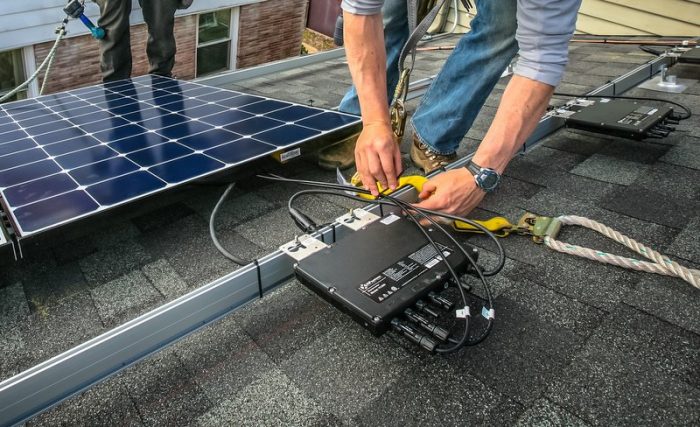
Whether a prospective solar customer is looking to save money on their utility bill or would like to help the planet, as a salesperson, your job is to show them how a solar system will be worth their investment. In many cases, offering products equipped with module-level power electronics (MLPE) could be the difference between making a sale or not.
For a long time, the popular conception about solar panels was that they weren’t ready for prime time and that the technology wasn’t efficient enough for wide adoption. That all changed when MLPE came onto the scene. While MLPE isn’t for every solar system, it remains a top selling point when it comes to convincing consumers that the time is now to go solar. This is especially true of residential solar systems, the vast majority of which utilize MLPE.
What makes MLPE so attractive to homeowners? Both microinverters and dc optimizers solve some of the problems that can arise in solar systems that use regular string inverters. These problems can have a big impact on the value proposition for prospective customers. Here are some of the top benefits MLPE offer that you can use to secure a sale:
Shading and soiling losses
Shading and soiling losses are a major cause of hesitancy in solar customers—and with good reason—but MLPE can go a long way in recapturing some of these losses. A string inverter requires a minimum amount of operating voltage to turn a significant portion of the array on every day. Ideally, the sun rises in a clear sky, and the system soon begins generating electricity. The trouble starts, however, when it’s a cloudy day or modules get dirty or otherwise obstructed.
If one panel in a string is affected by shading or soiling, every panel after it in the sequence will be as well. Conceivably, this could cause the entire string to underperform enough that the inverter could fail to reach operating voltage. This issue is compounded if multiple strings are affected—say, an animal decides to build its nest on the connection between two strings. A customer might go months before realizing that their solar system isn’t saving them any money.
To prevent scenarios like this, the customer has to regularly maintain their system—clearing debris, trimming trees, and other upkeep. That could be an obstacle to going solar at all for many customers. With MLPE systems, though, some of that upkeep anxiety is mitigated because of module-level MPPT functionality, which ensures that each module’s output is maximized, regardless of any panels around it that might be underperforming.
Design flexibility
Increased design flexibility is another way MLPE can help customers maximize their solar systems.
Because every roof is different, the more rigid requirements for strings can sometimes limit the number of modules you’re able to install. This might impact the value proposition enough that you lose a customer. With MLPE, however, if there is a small roof plane that gets good sun, you might be able to fit in another couple of panels there without needing to wire attic runs or come up against firewalls.
If maximizing roof space requires panels to be at different orientations, MLPE will also compensate for orientation mismatch loss.
Monitoring and remote functionality
Another way MLPE maximizes value is in its robust monitoring and remote capabilities, both at the module and fleet levels. For example, in the previous scenario, with the nest knocking out a significant percentage of an array, a customer whose system’s smart monitoring offers performance metrics would be able to quickly detect a problem before it began to significantly raise their electricity bills.
Occasionally, a solar system just needs to be reset, as a laptop or cell phone might. In many MPLE systems, the installer can remotely isolate the problematic panel and restart it. This connectivity also allows for more responsive fleet management for in-person maintenance.
Compliance and safety
Rapid shutdown requirements are in effect in most states and have been steadily gaining traction across municipalities in states that have not yet adopted the relevant NEC. These requirements protect firefighters if they ever have to ventilate your roof during a fire. Module-level shutdown is important because even if a string inverter is turned off, the wires coming off panels will still carry a current and could pose a danger. MLPE, whether a microinverter, optimizer, or dedicated shutdown device, can cut off the power at the individual panel level.
Though a customer’s locality might not currently require rapid shutdown, it could in the future—in which case, they might want to install it upfront. Regardless, the additional safety, as well as the potential to limit the damage of a fire, are both attractive selling points for customers. In those modules with remote functionality, a customer might even be able to shut off power themselves through an app on their phone. This would be particularly useful if a neighbor alerted them to a fire while they were not at home.
Who Is MLPE For?
Module-level power electronics aren’t a one-size-fits-all solution. If a customer wants to install a large array on the roof of a commercial building, opting for microinverters on each panel might not be cost-effective. If they have a maintenance team to keep the system in working order, some of the benefits of MLPE become less important. However, for a homeowner with a 30-panel array who doesn’t want to worry about maintaining their system, MLPE just might be what puts them over the top in committing to going solar.
John Bumgarner is General Manager of Solar and Storage for Mosaic, a leading financing platform for U.S. residential solar and energy-efficient home improvements. Bumgarner is a longtime solar industry professional with nearly 15 years of experience managing new partner development and training, business intelligence and portfolio management.
— Solar Builder magazine
[source: https://solarbuildermag.com/residential-solar/how-mlpe-helps-seal-home-solar-sales/]
Leave a Reply
You must be logged in to post a comment.